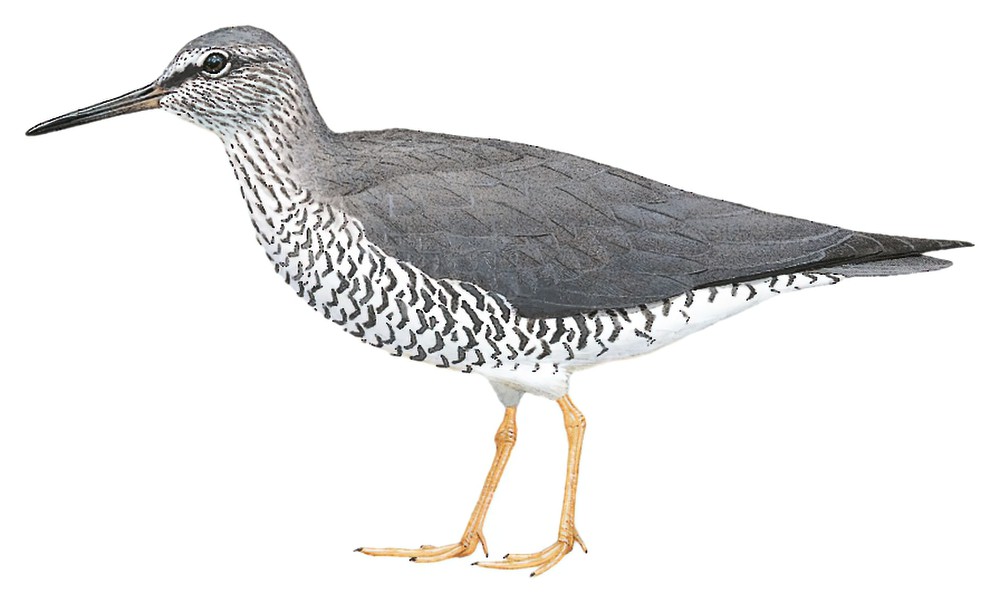Wandering Tattler / Tringa incana

Wandering Tattler
SCI Name:
Protonym: Scolopax incana Syst.Nat. 1 pt2 p.658 dSM
Taxonomy: Charadriiformes / Scolopacidae / Tringa
Taxonomy Code: wantat1
Type Locality: Eimeo [= Moorea of the Society Group] and Palmerston Islands.
Author: Gmelin, JF
Publish Year: 1789
IUCN Status: Least Concern
DEFINITIONS
TRINGA
(Scolopacidae; Ϯ Green Sandpiper T. ochropus) Late Med. L. tringa name given to the Green Sandpiper by Aldrovandus 1599 < Gr. τρυγγας trungas thrush-sized, white-rumped wading bird that bobs its tail, mentioned by Aristotle, not further identified, but taken by later authors to be a sandpiper, wagtail, or dipper; "78. TRINGA. Rostrum teretiusculum, longitudine capitis. Pedes tetradactyli: postico uniarticulato a terra elevato." (Linnaeus 1758); "Tringa Linné, Syst. Nat., ed. 10, 1, 1758, p. 148. Type, by tautonymy, Tringa ocrophus Linné (Tringa, prebinomial specific name in synonymy)." (Peters 1934, II, 264). Linnaeus's Tringa comprised thirteen species (T. Pugnax, T. Vanellus, T. Gambetta, T. Interpres, T. tobata, T. Fulicaria, T. alpina, T. Ocrophus, T. Hypoleucos, T. Canutus, T. Glareola, T. littorea, T. Squatarola).
Var. Trunga, Trynga, Tryngas, Tringra, Trinca, Frinca, Fringa.
Synon. Aegialodes, Carites, Catoptrophorus, Erythroscelus, Gambetta, Glottis, Helodromas, Heteractitis, Heteroscelus, Hodites, Iliornis, Limicula, Nea, Neoglottis, Ochropus, Pseudoglottis, Pseudototanus, Rhyacophilus, Totanus.
● (syn. Calidris Ϯ Red Knot C. canutus) “Type by subsequent designation of Gray (List Gen. Bds. 1st ed. 1840, p. 69): T. canutus Linn. If the method of Linnean tautonymy be followed, the type of the genus must be ... Tringa ochropus Linn.” (BOU 1915).
● (syn. Vanellus Ϯ Northern Lapwing V. vanellus) "GENUS 115. TRINGA Lin. Cuv. Lath. Dumer. Vanellus Briss. Bechst. Meyer. Parra LaCépède. (Kibitz Germ. Vanneau Gall. Lapwing Angl.) ... Species: Tringa Vanellus, varia Lin. Parra Cayennensis Lin Gmel. Observat: Tota avis, praesertim secundum rostrum, ita similis est Charadriis, ut, demto halluce, discrimen vix restet. Caeterum observo, Tringae characteres a Linnaeo enumeratos, cum solis Vanellis Auctorum quadrare, nec cum Actitibus, quas cum illis confuderat. Nomen Tringae hanc ob caussam Vanellis servandum erat" (Illiger 1811).
INCANA
(Cisticolidae; Ϯ Socotra Warbler I. incana) Specific name Cisticola incana P. Sclater & Hartlaub, 1881; "Cisticola incana Scl. & Hartl., P. Z. S. 1881, p. 166, pl. 15. TYPE in British Mus., "♂ coll. by Prof. Balfour, 23 March 1880, on Sokotra Is."; imm. ♂, wing 50, tail 44: examined and judged to be, not a Cisticola, but more like a Franklinia, probably best classified as the Type of:- Incana incana genus nov., defined thus:- Form. Near Franklinia, viz. bill long, very straight, slender and much compressed apically; feet rather large; wings short, obtuse, weak (the foregoing copied from the orig. descr. in P. Z. S. 1881, to which add); texture of plumage loose and soft, particularly dense and puffy on lower back and rump; but tail Cisticoline, less steeply graduated than Franklinia, and rectrices not so narrow (twelve in no., as in both sp.). Coloration (Only Summer and juvenile dresses known) Plain brownish grey above and white below; more like Franklinia than any species of Cisticola, except tail which is of Cisticoline spotted fan pattern above and below, with white tips and outermost edgings, that of the male Summer dress also with conspicuous white mirrors. Habits (according to description). Much more like Franklinia than Cisticola." (Lynes 1930).
incana
L. incanus light grey, hoary, quite grey.
● ex “Grey-poll Warbler” of Latham 1783, and Pennant 1785 (?syn. Dendroica fusca).
● ex "Ash-coloured Snipe" of Latham 1785 (Tringa).
UPPERCASE: current genus
Uppercase first letter: generic synonym
● and ● See: generic homonyms
lowercase: species and subspecies
●: early names, variants, mispellings
‡: extinct
†: type species
Gr.: ancient Greek
L.: Latin
<: derived from
syn: synonym of
/: separates historical and modern geographic names
ex: based on
TL: type locality
OD: original diagnosis (genus) or original description (species)












